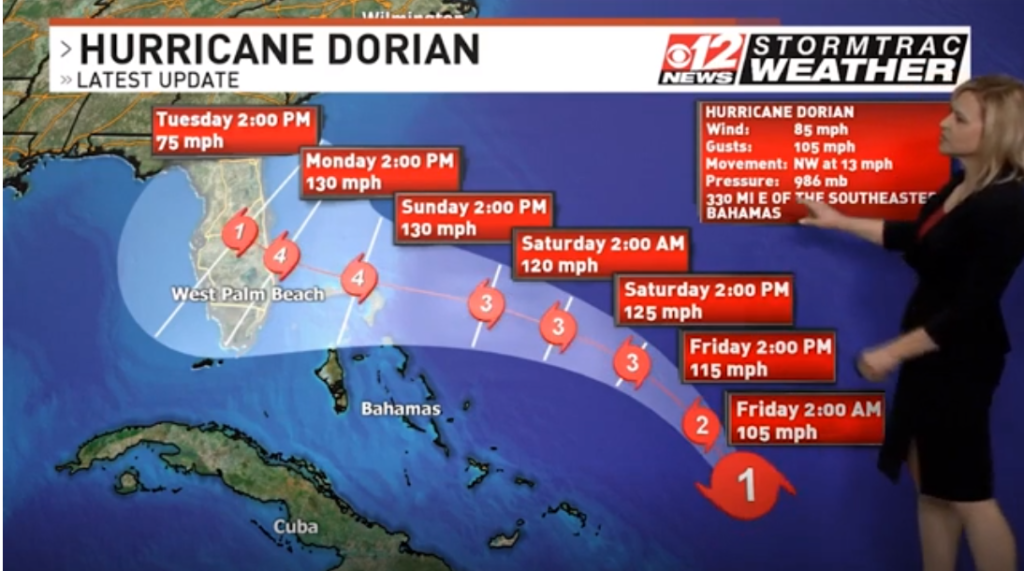
December 2019 seems like eons ago.
Just a couple months before COVID rocked our world, a pretty serious hurricane named Dorian was barreling toward the east coast of Florida, threatening to cause havoc, damage, and potentially, a loss of life.
It’s Throwback Thursday here on JacoBLOG, and a perfect time to pull out a post written just before Dorian hit the U.S. mainland, tragically killing six Americans in its wake.
Now 20 months later, natural (and manmade) disasters are coming at us at a fast and furious pace. Hurricanes, wildfires, droughts, floods – they’re seemingly daily occurrences. Not to mention pandemics.
If you’re programming a local radio station when disaster strikes, you’re in that rare and critically important position to do some spectacular things to keep your community prepared, informed, comfortable, and safe.
WWL in New Orleans is a station with that reputation. And it’s deserved. As the Washington Post reported, the station pulled off amazing coverage for its hurricane ravaged populace. Programmer Diane Newman is a superstar – a veteran of Katrina – and the person you want running the show when the bad stuff hits the fan.
But you don’t need to be the big News/Talker – or even the Public Radio station – when trouble comes to your town. These days, you simply need to have live, intuitive talent on the air who understand their community and the gravity of the moment.
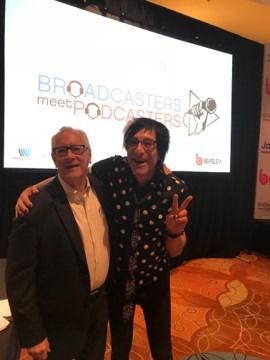
That was the case for WMMR in Philly when their region was suddenly swamped by flood waters last week. As we know from post-coverage, New York, New Jersey, and yes, Philadelphia, were caught off-guard by this waterlogged disaster.
Of course, it all occurred at night, and one of the few live – and yes, local – personalities on the air was MMR night host, Jacky Bam Bam. As Beasley market manager, Joe Bell, told me, “Thank God we’re live at night on MMR and the Fanatic. I just never thought I’d be getting my primary storm info from Jacky ‘The Weatherman’ Bam Bam! We’re lucky there weren’t more casualties and more damage than there was!”
Today’s blast from the recent past is all about radio’s role during these break points – how it can be in the moment and make a difference.
Or be asleep at the switch. – FJ
One of the most challenging aspects for local media outlets covering emergencies is that we usually don’t see them coming. Tornadoes, school shootings, rock star deaths – rarely do we have much notice that impending disaster is upon us.
Until it strikes.
And as we’ve discussed so often in this space, these emergencies also have a nasty habit of occurring at night, or worse, over the weekends where radio station buildings are either lightly staffed or the whole place is on auto pilot.
But in the case of hurricanes, we have advance notice – often days ahead. That’s the case with Hurricane Dorian. It’s been forming for days now, and meteorologists all over the world are tracking it. Dorian has already blown through the Virgin Islands and Puerto Rico. And now it’s headed right for the east coast of Florida. We even have a pretty good idea when it will hit, even if we don’t know with any certainty precisely where it will wreak the most havoc.
This gives media brands – particularly, radio stations – a chance to prepare. If there’s a news station in your building, it might become the center of the cluster’s coverage. Perhaps your station or group already has an arrangement in place to simulcast or co-broadcast with a local TV station. We always recommend that every radio outlet has an emergency plan in place for potential catastrophes like this one.
Whatever the case may be, an impending disaster like Dorian is a chance for radio to do what it (should do) does best – provide emergency local coverage and serve its communities.
It matters. In Techsurvey 2019, we asked respondents to tell us why they enjoy listening to broadcast radio. You may have seen the chart below, showing the main reasons why consumers love radio. Usually, we focus on music, personalities, and those “emotional benefits,” such as companionship or mood elevation.
But as the chart shows, emergency coverage is one of those buttons that matters to listeners – especially when they’re literally looking into the eye of a hurricane.
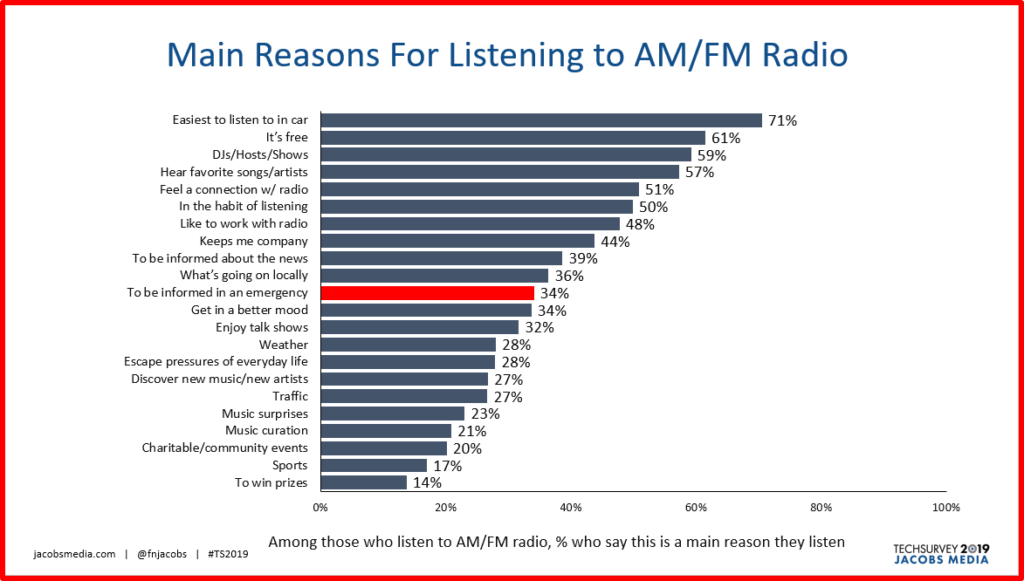
Just over a third of respondents tell us that being informed in the event of an emergency is a key reason why people turn to AM/FM radio. I have a feeling if we surveyed Floridians this afternoon, that percentage would be on the rise.
And while no one wants to exploit a local disaster, the fact is many radio stations do provide solid coverage during emergencies, often winning them recognition, respect, and even Marconi Awards. In fact, I’ve sat through enough of those NAB dinners to know that above-and-beyond coverage during emergencies often wins broadcasters those coveted glass trophies.
Of course, recognition is not why the hard working, dedicated men and women in radio will do their best this weekend. They do it because that’s what you do when these disasters are upon us.
Yet, most radio stations don’t get out in front of these situations, even on a day like today when every broadcaster in Florida (and Georgia and other coastal communities) knows precisely what may happen over this Labor Day weekend.
Like Chase Bank did.
That’s right – a multi-national financial institution with more than 250,000 employees in 100 countries with assets of $2.49 trillion (as of 2016) took the time to send Lori Lewis the email you see below.
Chase is bigger than every U.S. radio company combined, but somehow, Thasunda Duckett, Chase’s CEO of the Consumer Bank, took the time to assure a valued customer the bank has her covered.
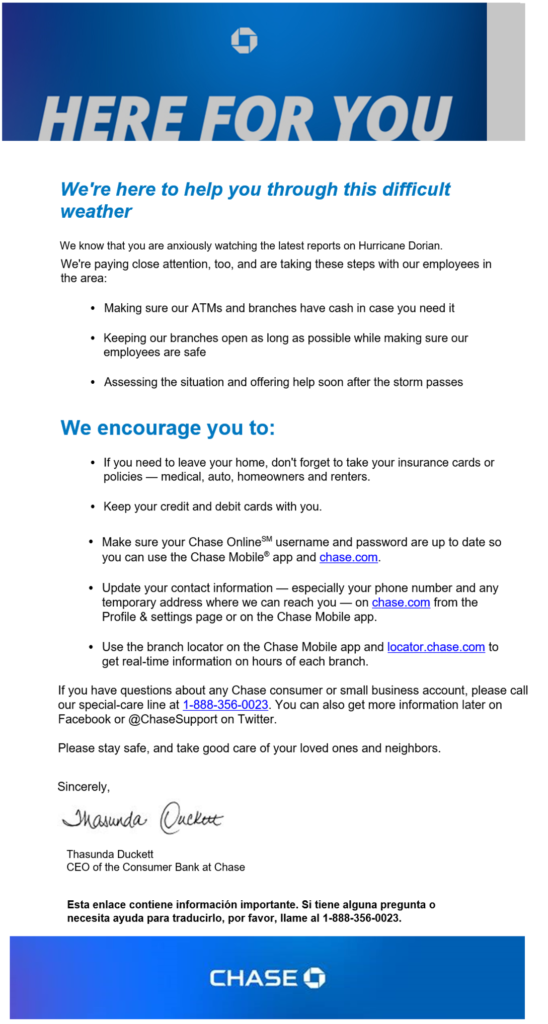
As you can see in this missive, Thasunda even reminds Lori how to prepare in the event she has to evacuate her home. Not only is it a small piece of reassurance in an otherwise scary situation, but it’s what you’d hope your bank – or your radio station might do.
Reminding listeners of how your station intends to handle coverage, the importance of having a battery operated radio (and having plenty of batteries), and providing the direct line into the studio(s) to report up-to-the-minute news and information is all part of the communications strategy stations in Dorian’s path should be executing.
It’s not just about having a disaster plan – it’s about having a communications strategy.
Of course, Chase doesn’t have a microphone, a transmitter, or a tower – so, it’s all about email. These same radio stations in Dorian’s path could also use this same messaging on the air all weekend long, reassuring their audiences and making their commitments to stay on the air as long as possible to serve their communities.
I wouldn’t count on Pandora, SiriusXM, Spotify, or Wondery providing this type of service during a critical moment in people’s lives.
That’s why they listen to radio – their media port in the storm.
- Media And Technology In 2025: Believe It Or Not! - April 18, 2025
- In Radio, You Just Never Know - April 17, 2025
- The Secret To Making A Great Podcast (And Great Radio) - April 16, 2025




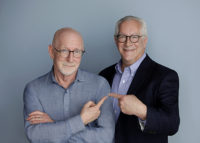
Serving your signal area in the Public’s Interest, Convenience and Necessity will Always be essential. It’s what makes radio content and broadcast connection work, thrive and serve.
Another bullseye, Fred.
Scene 1 – sitting in a local NPR office talking about how bad it sounds repeating an afternoon drive show later that night. In suggesting a different approach I ask “you do understand that something in the news could be completely irrelevant a few hours later, right?” I am answered with a shrug.
Scene 2 – sitting in a PD’s office with an offer to do weekend shifts, I instead offer to image the weekends in advance. PD says “our audience heads off to Home Depot or soccer practice, and they need live weather updates – just a smart touch” – and of course he’s right.
I really hope programmers take their role more seriously. Radio is still a lifeline for many. Current information is always important, and the lack of it can be deadly.
Thanks for this, Tai. And I don’t think it’s a matter of cable news simply tacking a “BREAKING NEWS” banner onto just about everything (although there is that). There are more of these moments, and umpteen opportunities for radio to be in the moment and frankly, do its job.